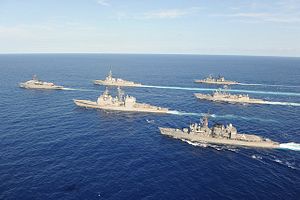What will the future of war look like in East Asia? A recent conference at the Pandia Calogeras Institute, a think tank associated with the Brazilian Ministry of Defence, examined potential developments in warfare with an eye toward 2045. Here are several trends the group identified, with implications for thinking about how conflict may develop in East Asia:
A New Set of Security Players
Currently, states dominate the land and seascapes of geopolitics in East Asia. But as we’ve recently learned in the Middle East, and as we’ve long known in Latin America and elsewhere, sub-state and trans-state groups can loom large on the threat matrix. Ideological movements, ethnic groups, religious communities, and transnational criminal networks may reassert themselves in the Asia-Pacific, giving states something to worry about beyond a few uninhabited islands. Developments of this sort could drive interstate cooperation, and potentially change how regional militaries approach planning for war.
War and the Growth of Inequality
Will future conflicts in the Asia-Pacific happen within states, between states, or across states? Developments in economic inequality may affect this question. Although it’s tough to draw a straight line between inequality and conflict, and (controversial) work of French economist Thomas Piketty suggests some potential fruitful ideas. Piketty argues that wealth inequality in many countries is approaching historic highs, which could create crises of legitimacy across several states. These crises could lead to risk-acceptant behavior, or to internal disintegration.
At the same time, Piketty is clear that major power war in the twentieth century proved the great “leveler” in terms of wealth inequality. The wars destroyed a tremendous amount of property, undermined the great European empires, and led to inflation and high rates of taxation, all of which produced a far more egalitarian distribution of wealth.
Evolution of the Laws and Morality of War
Designed for regulating wars between states, the laws of armed conflict have reacted to transformation in conflict only with great unease. Developing and applying rules for managing conflict between state and non-state actors has dominated legal thinking on war for the last decade. These debates will surely matter for how East Asian states approach war, but an even larger problem looms; the advent of autonomous and semi-autonomous weapon systems will challenge the current regimes guiding the use of armed force, even in inter-state conflict. As states embrace “killer robots,” will the rules catch up, and how will those rules affect government decision-making? Yet international law is characterized by its ability to grow and change under new circumstances, and we may see such change as we gain more perspective on the Wars on Terror.
Interoperability is King, but He is a Demanding Monarch
The ability of the United States to act in concert with militaries across the Asia Pacific will, in large part, determine its prospects in a conflict with China. Similarly, the willingness of partner nations to make the sacrifices the interoperability demands will provide the clearest indication of a commitment to balance against Chinese power. Technical compatibility is only part of the problem; partners need to work together to ensure tactical and operational coherence. Finally, they need to sort through in advance the demands and caveats made by political authorities.
Identifying military and security trends some thirty years out has always been perilous. Looking back, it’s tough to imagine how analysts sitting in 1985 could have predicted 2015, or 1955 1985, and so forth. Still, given the length and expense of modern procurement projects, we need to make some effort at long range projection.
































